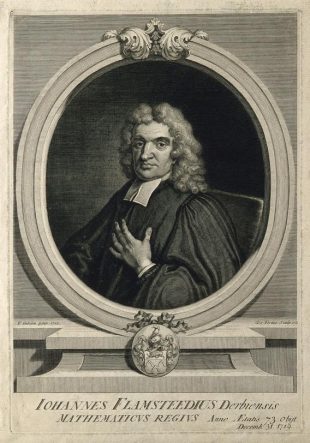…where east meets west
- Home
- Brief History
- The Greenwich Meridian
- Greenwich
(1675–1958) - Herstmonceux
(1948–1990) - Cambridge
(1990–1998) - Outstations (1822–1971)…
- – Chingford (1822–1924)
- – Deal
(1864–1927) - – Abinger
(1923–1957) - – Bristol & Bradford on Avon
(1939–1948) - – Bath
(1939–1949) - – Hartland
(1955–1967) - – Cape of Good Hope
(1959–1971)
- Administration…
- – Funding
- – Governance
- – Inventories
- – Pay
- – Regulations
- – Royal Warrants
- Contemporary Accounts
- People
- Publications
- Science
- Technology
- Telescopes
- Chronometers
- Clocks & Time
- Board of Longitude
- Libraries & Archives
- Visit
- Search
In life and in death: The changing fortunes of John Flamsteed
Flamsteed Astronomy Society Lecture, 24 April 2025
This page is intended to support a lecture given by Graham Dolan

John Flamsteed. Line engraving by G. Vertue, 1721, after T. Gibson, 1712. Image courtesy of the Wellcome Collection (see below)
The 1712 & 1725 Historias
Flamsteed's Historia Coelestis - links to online copies and a guide to the different sections
Flamsteed’s Historia Coelestis and the etchings of Francis Place – a comparative study
Text of the Warrant setting up the Board of Visitors (1710)
The supressed preface to Flamsteed's Historia
Solar eclipse observations & Correspondence
Solar eclipses observed at Greenwich during the time of Flamsteed (1675–1719)
Atlas Coelestis
High resolution copy from the Linda Hall library (1729)
High resolution copy from the Linda Hall library (1753)
High resolution copy from the University of Zurich library (1753)*
* This copy lacks the frontispiece (portrait of Flamsteed) but has better scans of the star charts
The Giant Steps
The Royal Observatory and the Giant Steps (the Grand Ascent)
Burial and monuments
The Burial Place of John Flamsteed, the first Astronomer Royal
Telescopes
7-foot Equatorial Sextant (1676)
Hooke's 10-foot Mural Quadrant (1676)
Planning applications lodged with Royal Borough of Greenwich
Planning application relating to the Giant Steps:
Application relating to the Royal Observatory
The text of the letter from the Royal Astronomical Society objecting to the demolition of Flamsteed's Sextant and Quadrant House can be found in the Officer's Delegated Report.
The planning documents refer to Flamsteed's Quadrant and Sextant Houses as the "ticket office".
The Sextant and Quadrant Houses are of great heritage significance as:
- They were designed by Sir Christopher Wren
- Are grade 1 listed and part of a scheduled ancient monument as well as being within a World Heritage Site and conservation area
- Unlike Flamsteed House which Wren stated he had designed ‘for the observator's habitation and a little for pompe’ they were the beating heart of the Observatory and remained so for the first forty of so years of its existence.
As part of a Grade 1 listed building and scheduled ancient monument the Sextant and Quadrant house has the highest degree of protection that can be given. None the less, the Royal borough of Greenwich with the support of Historic England have agreed to their demolition.
The listing (Grade 1) for the Meridian Building states:
'C17 and C18 two storey brick building with C19 and modern alterations. This contains the transit telescopes of three Astronomers Royal, with a collection of other relevant material; and the finally decided Prime Meridian runs through the eastern part. A series of rooms on the south side fitted and furnished as if to be used by the first Astronomer Royal in late C17.'
Digitial copies of manuscripts relating to the publication of the 1712 Historia
From the University of Cambridge
From the Macclesfield Collection, CUL (MS Add.9597/13/6/72a-87)
From Newton's Papers, CUL (MS Add.4006)
From the Royal Society
Videos
Modern papers
An analysis of the errors in John Flamsteed’s mural arc observations. William Blitstein, Vistas in Astronomy Vol. 41, No. 1, pp. 139-155 (1997)
The seven identified observations of Uranus made by John Flamsteed using his mural arc. William Blitzstein, The Observatory, vol. 118, p9. 219-222 (1998)
Flamsteed's lunar data, 1692-95, sent to Newton. N Kollerstrom, & B.D. Yallop. Journal for the History of Astronomy, p.237-246 (1995)
Other Reading
© 2014 – 2025 Graham Dolan
Except where indicated, all text and images are the copyright of Graham Dolan